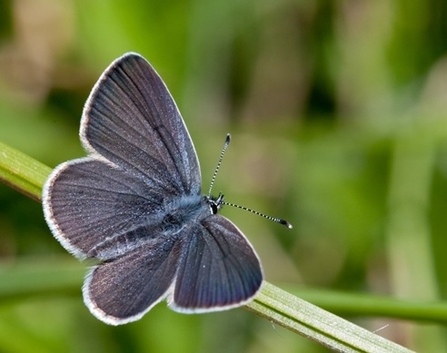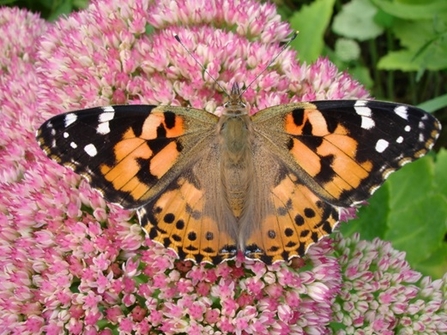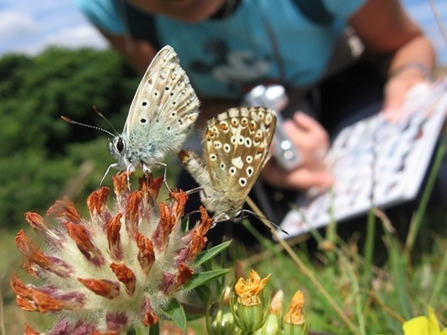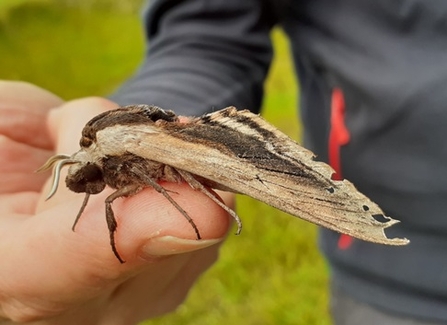As part of my role as the Butterfly Conservation Project Officer I have enjoyed getting out and about recording butterflies and moths across the project area. A butterfly or moth record consists of a few key pieces of information including the species seen, number of individuals, site location and date. This work supplements existing data, collected by volunteers, by ensuring we have up to date records on both the project nature reserves and surrounding greenspaces. The records can then be analysed to determine which species are in decline, where to find them and to help identify opportunities for species expansion. New and improved chalk grassland habitat will help support the expansion of threatened butterfly species, such as the small blue, by boosting populations on nature reserves and by creating new habitat or ‘stepping stones’ between nature reserves and greenspaces.
Butterfly and moth recording with the Brilliant Butterflies team
Small Blue at Hutchinson's Bank credit Daniel Greenwood

Small Blue - Steve Bolton
Where new habitat is created nearby an existing nature reserve butterflies and moths will begin to colonise and start a new breeding population in time. For example, we are in discussion with the Friends of Sanderstead Recreation Ground about the potential for creating new areas of wildflower habitat on the recreation ground to support butterflies and moths that will colonise from Riddlesdown Common.
Records collected this year will provide baseline information which can be compared to records in future years when we expect to see a greater variety and abundance of butterflies across the project area. Habitats across London support over 40 of the UK’s 59 butterfly species but many are in decline. There are a number of methods of recording butterflies and moths including butterfly transects, recording presence of butterflies using iRecord and moth trapping. A butterfly transect is the best way of monitoring butterfly populations in the long term by walking a set route, often in a nature reserve or park, every week between April and September and recording all the butterflies seen. Population trends can then be determined when comparing years.
Recording the presence of butterflies in gardens, parks and greenspaces provides valuable information about their status and the health of the environment. Butterflies and moths are good indicators of environmental change and the quality of our countryside and urban landscape. They are easy to record and identify and can be used as a barometer for the fate of many thousands of other, less well-known insects. Records contribute to the national picture of butterfly and moth populations and help target conservation effort and increase the understanding of our changing climate.
The iRecord Butterflies app is a great tool for both identifying and recording butterflies in any location from your garden to your local greenspace and will help paint a picture of local butterfly distribution. Its great fun too as different species come and go throughout spring and summer and occasional migrant butterflies appear like the beautiful painted lady, see picture.

Painted Lady - Steve Bolton
The Big Butterfly Count is an annual UK-wide survey aimed at helping assess the health of our environment simply by counting the amount and type of butterflies (and some day-flying moths) we see over a three-week period in July and August. 2019 saw 116,000 counts submitted from all over the country! You can download a handy identification chart or free app to identify and record the butterflies you spot and look at the fascinating interactive map to see how your data is contributing to conservation science.

Butterfly recording - Steve Bolton
In addition to recording butterflies I have also been recording moths using a light trap. Moths are amazing, beautiful, diverse, and they are all around us. Many of the nocturnal moths are attracted to light where they can be easily identified and recorded the following morning before being safely released. The records provide vital resources to underpin nature conservation. National moth week runs from July 18 – 26 and where many events across the country provide an opportunity to celebrate, learn, observe and contribute scientific data about moths.

Privet hawk moth
Photo credit: Steve Bolton
We have not been able to run the planned butterfly identification and moth trapping workshops this summer but please look out for these next spring if you would like to learn more. However, with the recording methods I have mentioned you can become a ‘Citizen Scientist’ and help contribute towards the conservation butterflies and moths this summer.
Brilliant Butterflies is a partnership between London Wildlife Trust, Natural History Museum and Butterfly Conservation, funded by a Dream Fund Award, thanks to players of People’s Postcode Lottery

